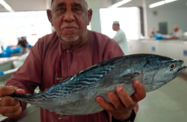Oman has moved forward with plans to develop the country’s first sugar refinery, part of a strategy aimed at improving domestic food security through agricultural processing.

On September 23 construction began on the OR134m ($350m), 188,000-sq-metre facility at the Sohar Port and Freezone.
Developed by Oman Sugar Refinery Company (OSRC) and constructed by China’s Sinolight Corporation, the plant will have annual output of more than 900,000 tonnes of refined sugar once fully operational.
In addition to meeting 100% of domestic refined sugar demand, estimated at 120,000 tonnes per year, the factory is also expected to add significantly to the sultanate’s export capacity.
When the project was first announced back in 2013, OSRC said it expected to export 40% of its output to markets in the Gulf region, where the shortfall of refined sugar is estimated to be 4m tonnes per year. If this export share remains consistent, Omani exports could therefore bridge around 10% of the current deficit.
Sohar Port and Free Zone developing into an agro-industrial hub
As sugar is as key staple ingredient for a large number of processed foods, the new factory is seen as a cornerstone project in the development of Oman’s first dedicated food-processing cluster at the Sohar Port and Freezone.
Launched in 2015, the cluster aims to support food industry growth by attracting investment in food-processing facilities, supply chains and logistics.
Another of the zone’s key feedstock projects, a $39m flour mill developed by majority-state-owned Oman Flour Mills, its subsidiary Atyab Investments and the UAE’s Essa Al Ghurair Investments, is expected to begin operations by the end of this year.
The mill, which is Oman’s third, will initially produce 500 tonnes of wheat flour per day, before scaling up to 2000 tonnes in later phases, according to local press reports.
Meanwhile, as part of further expansion, Sohar Flour Mills signed a lease agreement in April to build 12 wheat silos on a 10,000-sq-metre site at the freezone.
The silos, each with a capacity of 13,000 tonnes, are expected to become operational in the first half of 2020, and will offer storage for grains that will be transported to both local and international markets.
Additionally, the state-owned Oman Food Investment Holding Company is developing a $100m soya processing plant that will produce 750,000 tonnes of soy feed and 175 tonnes of soya oil annually.
Also scheduled for completion in 2020, the plant will not only boost Oman’s self-sufficiency in food oils, but will also provide important input for fodder used in the domestic poultry market. This prospect is generating foreign investment, according to local media, with leading players from Tanzania and UAE that specialise in the production of animal feed buying equity stakes in the factory.
At present, the sultanate is dependent on imports for soy feed. However, the mill is expected to satisfy 100% of the poultry market’s burgeoning demand for the product.
Further down the line, there is also the possibility that processed soya oil could be used by the pharmaceutical industry to produce capsules, opening further avenues for investment and revenue generation.
Processing key to food security goals
Improving processing capacity aligns with broader government strategies aimed at bolstering food self-sufficiency and reducing the country’s dependence on imports.
On the back of increased investment in recent years, the fisheries and agriculture sector expanded by 16.3% in 2016, well above its five-year average of 6.4%.
This increase, combined with a concomitant drop in oil revenue, saw the sector’s contribution to GDP rise from 0.7% in 2014 to 2% in 2016. With the sultanate planning to increase this further, to 5.1% by 2020, engaging the roughly one-third of the working population employed in agriculture and fisheries in value-added processing will be key.
This also ties in to efforts to bolster domestic food security.
Although Oman’s current situation is relatively strong – being ranked fourth out of 15 MENA countries and 29th out of 113 globally in the Economist Intelligence Unit’s Global Food Security Index 2018 – it sources some 60% of its food from overseas, according to the Public Authority for Investment Promotion and Export Development (Ithraa).
In a report released in July, Ithraa cautioned that an expanding middle class, growing tourism numbers and increasing urbanisation could place more pressure on domestic food supplies, and recommended the expansion of industrialised farming practices and food processing to strengthen food security.


